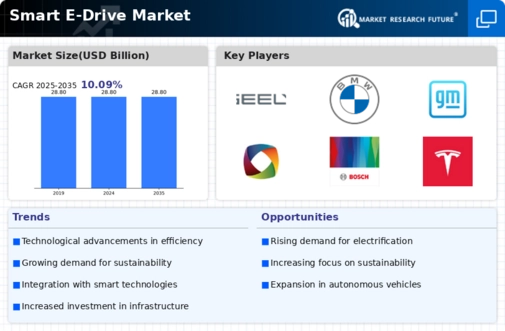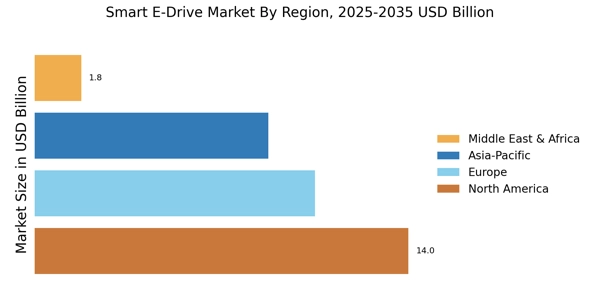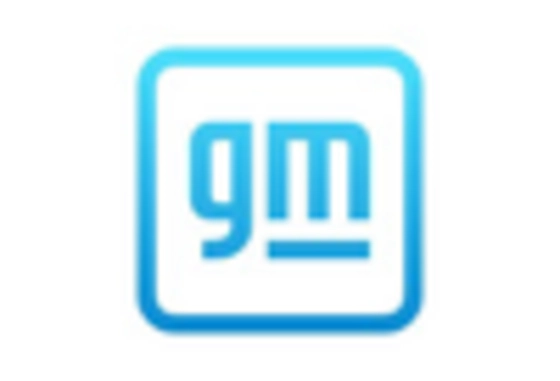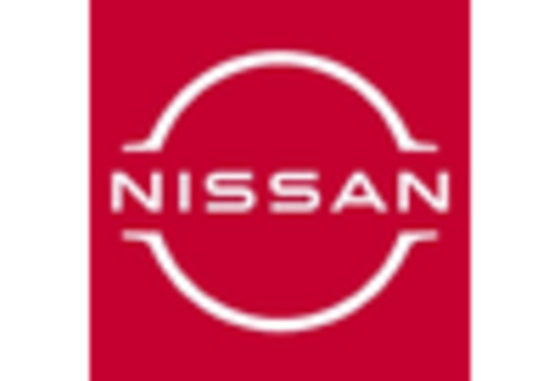Rising Demand for Electric Vehicles
The increasing demand for electric vehicles (EVs) is a primary driver for the Smart E-Drive Market. As consumers become more environmentally conscious, the shift towards EVs is accelerating. In 2025, it is estimated that the sales of electric vehicles will surpass 10 million units annually, reflecting a compound annual growth rate of over 20%. This surge in demand necessitates advanced e-drive technologies that enhance vehicle performance and efficiency. Consequently, manufacturers are investing heavily in the development of smart e-drive systems that offer improved energy management and driving experience. The Smart E-Drive Market is thus poised for substantial growth as automakers strive to meet consumer expectations and regulatory standards.
Increased Focus on Energy Efficiency
The heightened focus on energy efficiency is a pivotal driver for the Smart E-Drive Market. As energy costs rise and environmental concerns mount, both consumers and manufacturers are prioritizing energy-efficient solutions. The Smart E-Drive Market is responding to this demand by developing systems that minimize energy consumption while maximizing performance. For example, advanced regenerative braking systems are being integrated into e-drives, allowing vehicles to recover energy during braking. This not only enhances the overall efficiency of electric vehicles but also extends their range. As energy efficiency becomes a key selling point, the Smart E-Drive Market is likely to witness increased investment and innovation aimed at meeting these evolving consumer expectations.
Regulatory Support for Electric Mobility
Regulatory support is a vital driver for the Smart E-Drive Market. Governments worldwide are implementing stringent emissions regulations and offering incentives for electric vehicle adoption. In 2025, numerous countries are expected to have established policies that promote the use of electric vehicles, including tax rebates and subsidies for consumers. This regulatory environment encourages manufacturers to invest in smart e-drive technologies that comply with these standards. As a result, the Smart E-Drive Market is likely to benefit from increased production and sales of electric vehicles, driven by favorable government policies. The alignment of regulatory frameworks with market needs is expected to foster a conducive environment for the growth of smart e-drive systems.
Growing Infrastructure for Electric Vehicles
The expansion of charging infrastructure is a significant driver for the Smart E-Drive Market. As more charging stations are installed, the convenience of owning an electric vehicle increases, thereby encouraging consumer adoption. In 2025, it is projected that the number of public charging stations will exceed 1 million worldwide, facilitating easier access to charging facilities. This growth in infrastructure not only supports the existing electric vehicle market but also stimulates the development of smart e-drive technologies that can optimize charging processes. Enhanced charging solutions, such as fast charging and wireless charging, are becoming increasingly prevalent, further driving the Smart E-Drive Market. The synergy between infrastructure development and e-drive technology is likely to create a robust ecosystem for electric mobility.
Technological Advancements in E-Drive Systems
Technological advancements play a crucial role in shaping the Smart E-Drive Market. Innovations in battery technology, power electronics, and control systems are enhancing the efficiency and performance of e-drive systems. For instance, the introduction of silicon carbide (SiC) semiconductors is improving energy conversion efficiency, which is vital for electric vehicles. Furthermore, the integration of artificial intelligence and machine learning in e-drive systems is enabling real-time data analysis and optimization of energy consumption. As these technologies continue to evolve, they are likely to drive the adoption of smart e-drives, making them more appealing to manufacturers and consumers alike. The Smart E-Drive Market is thus experiencing a transformative phase, characterized by rapid technological progress.




















Leave a Comment